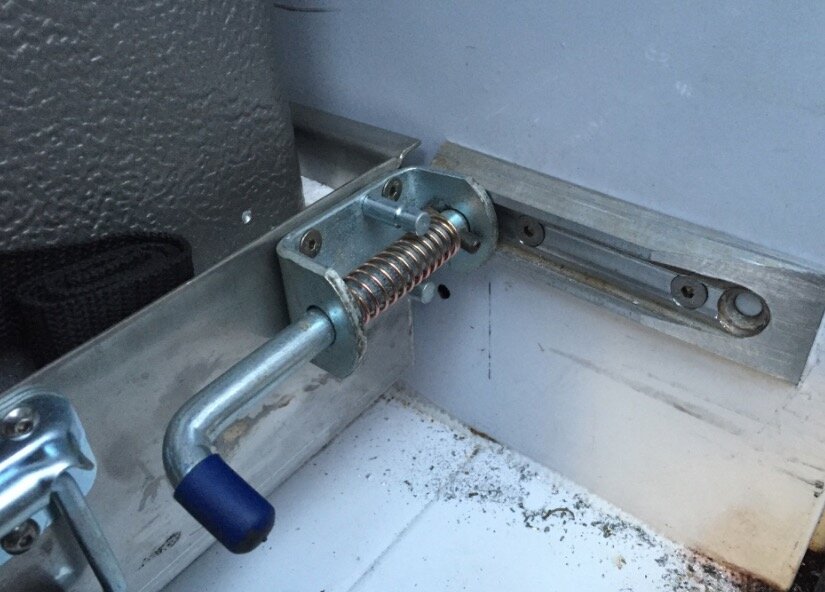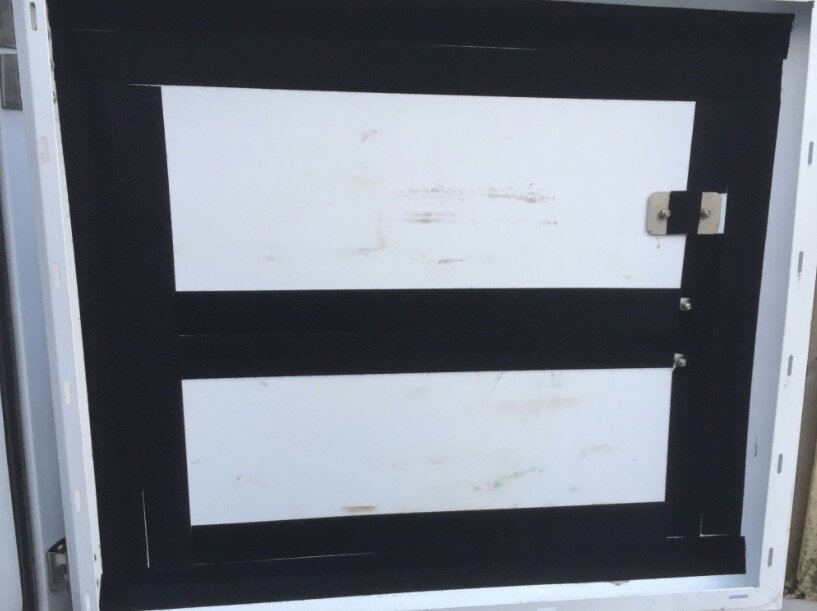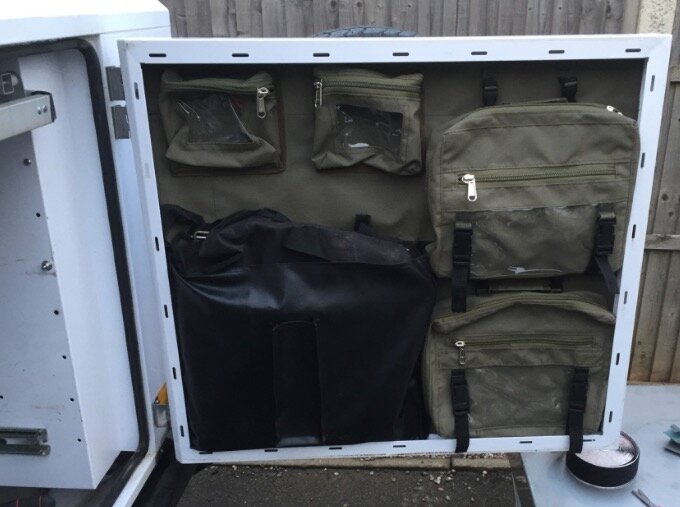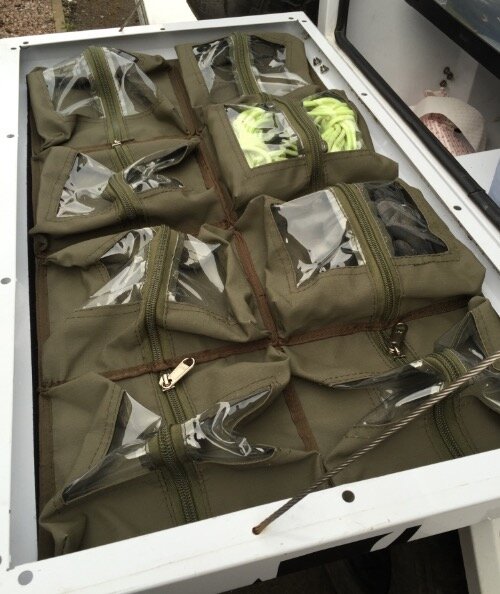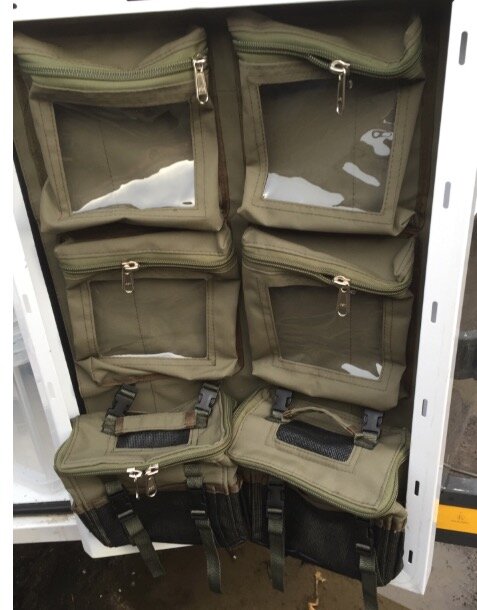Don't like the adverts? Click here to remove them
You are using an out of date browser. It may not display this or other websites correctly.
You should upgrade or use an alternative browser.
You should upgrade or use an alternative browser.
Thought I'd make my own adventure trailer...
- Thread starter Chris
- Start date
Great weather today. Raining with intermittent showers.
Managed to get the power all hooked up at last. Bought a nice little rotary switch and enclosure.
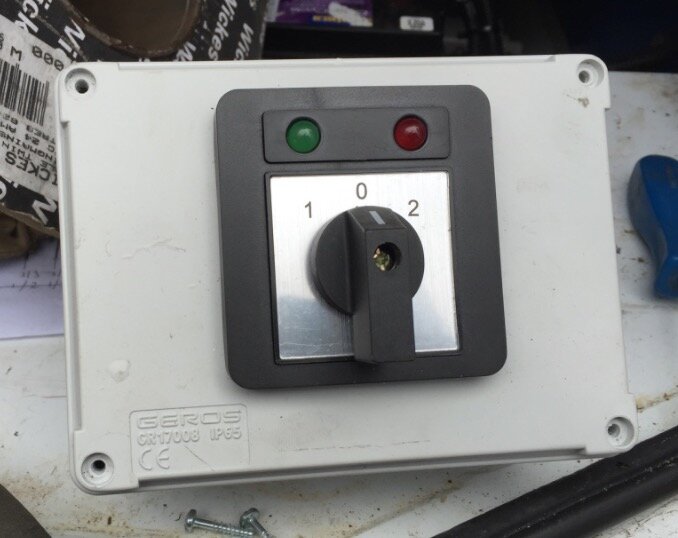
Mounted the switch.
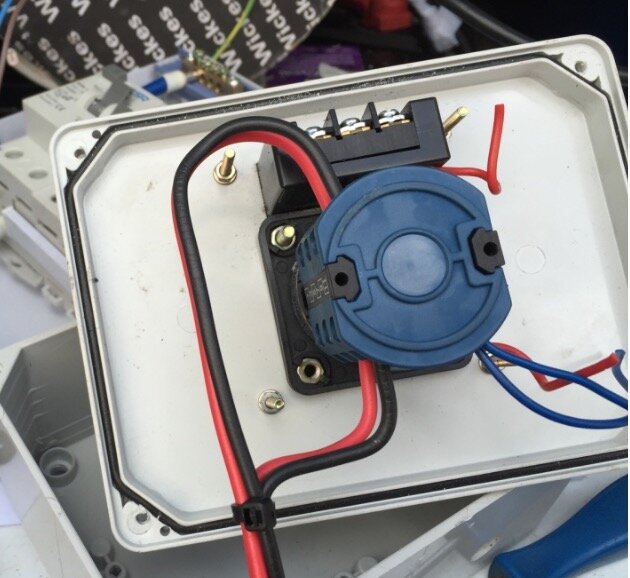
Got it all wired to swap between hook up and inverter with a clear break in between switchover.
Nailed it to the front bulkhead
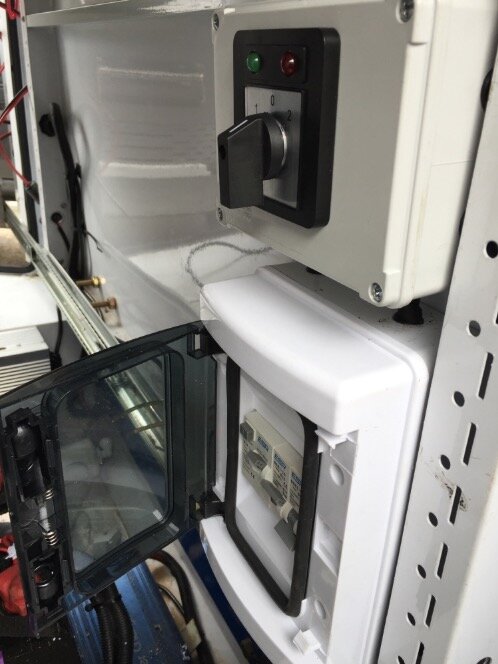
Got some decent earths in of course.
Plugged it in and guess what, it all works. The RCD trips as it should and everything. I do wonder though if I should have an earth spike to stick in the ground.
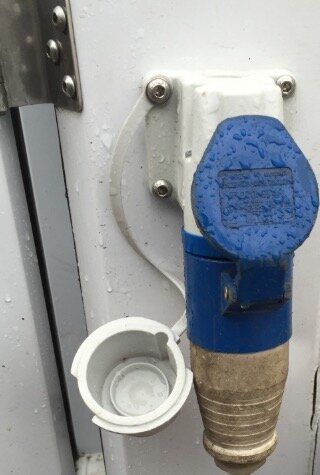
Plugs into my welding socket in the garage. I would like to add a charger in there so that when on shore power I can connect the batteries up and brim them for free. But that's for another day. There are indicator lights on the switch too but the rain beat me off today. I'll sort that next time it's not pouring.
I'd have liked a purse sine inverter as I said previously but the need for 240v in any regard is very limited so for the money, this decent mod wave unit will do. It runs an angle grinder and hair straighteners so we'll be fine. The unit in the truck is pure sine but only 600w.
Now. As I was doing this, Mrs Hermes turned up with a box. Hmm, now what might this be.
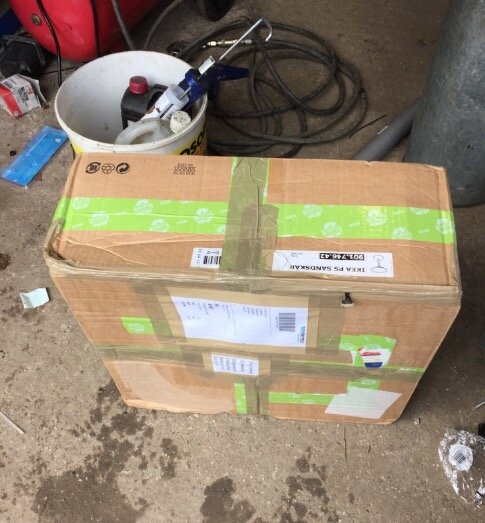
Well, it's my door caddies.
I had them made in Joburg, shipped to Matt in CT who put them in his suitcase and flew them specially to the UK for me. Then posted them for delivery today.
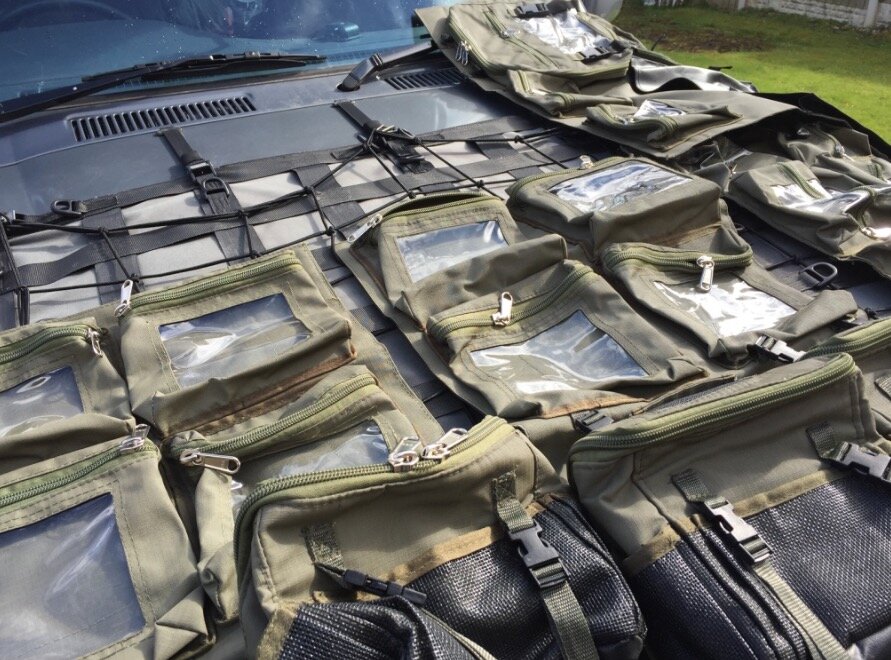
These fit in the doors and have all sorts of neat bags and pouches so of which are removable.
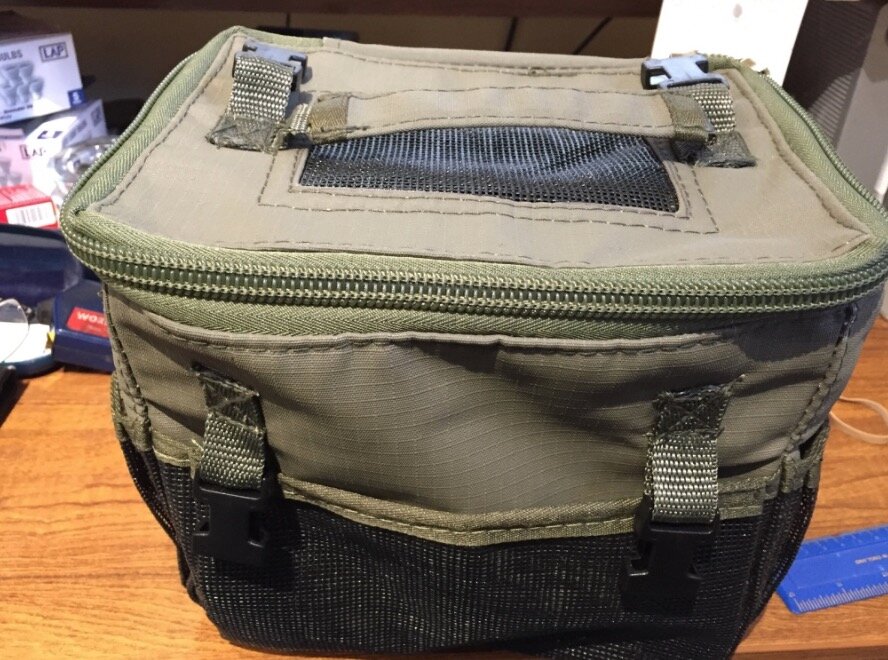
Beautifully made. But. errm, one of them isn't mine. They have made a mistake and sent me someone else's. It's actually probably fine. I'll see how I go with it.
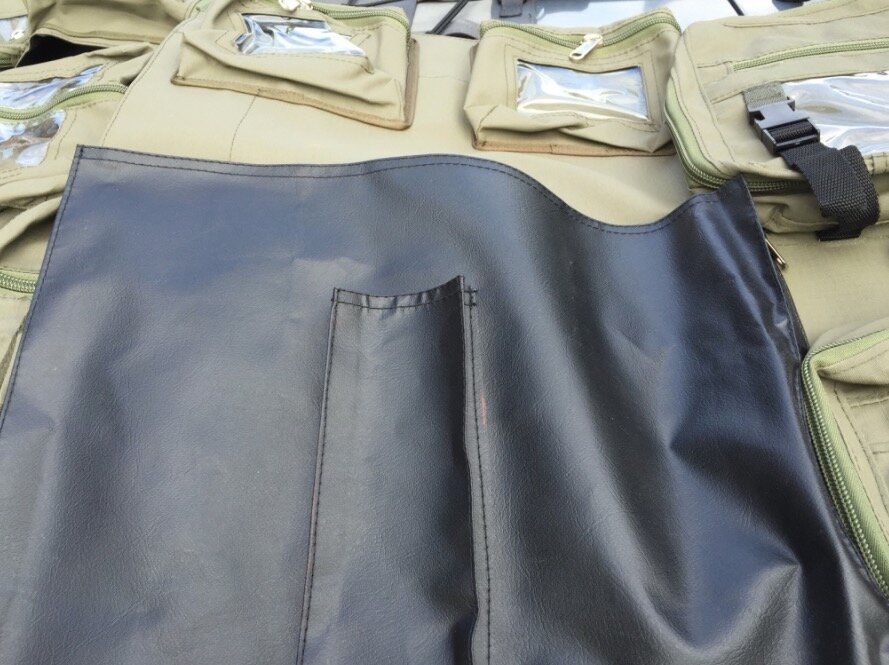
Managed to get the power all hooked up at last. Bought a nice little rotary switch and enclosure.

Mounted the switch.

Got it all wired to swap between hook up and inverter with a clear break in between switchover.
Nailed it to the front bulkhead

Got some decent earths in of course.
Plugged it in and guess what, it all works. The RCD trips as it should and everything. I do wonder though if I should have an earth spike to stick in the ground.

Plugs into my welding socket in the garage. I would like to add a charger in there so that when on shore power I can connect the batteries up and brim them for free. But that's for another day. There are indicator lights on the switch too but the rain beat me off today. I'll sort that next time it's not pouring.
I'd have liked a purse sine inverter as I said previously but the need for 240v in any regard is very limited so for the money, this decent mod wave unit will do. It runs an angle grinder and hair straighteners so we'll be fine. The unit in the truck is pure sine but only 600w.
Now. As I was doing this, Mrs Hermes turned up with a box. Hmm, now what might this be.

Well, it's my door caddies.
I had them made in Joburg, shipped to Matt in CT who put them in his suitcase and flew them specially to the UK for me. Then posted them for delivery today.

These fit in the doors and have all sorts of neat bags and pouches so of which are removable.

Beautifully made. But. errm, one of them isn't mine. They have made a mistake and sent me someone else's. It's actually probably fine. I'll see how I go with it.

Does the RCD trip on both 'shore power' and inverter, and what are the trip times on each?
Trip times? Don't think I'd be able to time it. It's like THUNK tripped
It trips in both modes
I'm not an electrician but all the wires are only touching where they're supposed to
Just not sure still how something that doesn't connect with the ground is earthed
That's the inverter in talking about as the shore power is earthed to the mains obviously
I've read the stuff about narrow boats and I get that but not quite clear on caravans etc
It trips in both modes
I'm not an electrician but all the wires are only touching where they're supposed to
Just not sure still how something that doesn't connect with the ground is earthed
That's the inverter in talking about as the shore power is earthed to the mains obviously
I've read the stuff about narrow boats and I get that but not quite clear on caravans etc
Towpack
Well-Known Member
RCD's sold for general protection should be double pole with 30ma/30ms trip. RCD's sense a current imbalance between the L & N conductors, not specifically a leakage to earth as a ELCB would, so will still offer protection if the vehicle isn't physically earthed, i.e. when using an inverter.
Don't like the adverts? Click here to remove them
An RCD needs checking when installed really. It needs doing with a meter and should take less than 200ms at X1 (30mA test current assuming a 30mA trip) and 40ms at x5 (150mA). This is important as the test button only exercises the mechanism which can become sticky if the grease goes a bit hard. We never used to test them. I even thought it was unnecessary to test them…until I started testing them and found several that didn't trip out of the box brand new. I test every single one I fit now.
It is a common misconception that the supply earth is the best earth. Wrong!! I don't care who says it or what argument there is, as long as there is correctly functioning earth leakage protection, the best earth is the one you stand on.
For the inverter, if it were used for anything more than on board items and the odd hand tool, one at a time, then running with no earth stake is acceptable. If it is to run more than one item at a time then it should have a REFERENCE earth stake of under 200 ohms to the earth. Well, you're not likely to be carrying an earth stake tester into the desert are you!
On 'shore power' generally there should be no stake, but there can be a stake to REFERENCE the earth around the trailer to the voltage present on the supply earth.
You have the possibility of plugging your trailer into any supply so a simple mains test adapter to ensure it is correctly connected like this one
https://www.ebay.co.uk/ulk/itm/291152078790
Or even better this one
https://www.ebay.co.uk/ulk/itm/151799226236
Is a very good addition to your setup.
You can have an 'earth' with just a stake as long as the RCD trips. However it is far more practical to use that provided by the mains supply. Provided it's there of course. Different countries employ different supplies. If in doubt, put a stake in and isolate from the supply earth. Don't forget that the 'earth' you are connecting to can be at ANY voltage but is seldom the same as that of true earth (what you be standing on). The earth wire is a conductor and as such can transmit a voltage back to (in this case) your trailer metalwork. You, with bared feet on ground, can make the final connection between the metalwork and the ground (true earth). If you have a stake, then true earth will be livened up around the stake in a voltage gradient to the same voltage as the metalwork of the trailer, hence even if it is at 230V, you will not feel enough voltage to hurt you. Oh, and this is before you even switch it on connecting Live and neutral to it.
It is a common misconception that the supply earth is the best earth. Wrong!! I don't care who says it or what argument there is, as long as there is correctly functioning earth leakage protection, the best earth is the one you stand on.
For the inverter, if it were used for anything more than on board items and the odd hand tool, one at a time, then running with no earth stake is acceptable. If it is to run more than one item at a time then it should have a REFERENCE earth stake of under 200 ohms to the earth. Well, you're not likely to be carrying an earth stake tester into the desert are you!
On 'shore power' generally there should be no stake, but there can be a stake to REFERENCE the earth around the trailer to the voltage present on the supply earth.
You have the possibility of plugging your trailer into any supply so a simple mains test adapter to ensure it is correctly connected like this one
https://www.ebay.co.uk/ulk/itm/291152078790
Or even better this one
https://www.ebay.co.uk/ulk/itm/151799226236
Is a very good addition to your setup.
You can have an 'earth' with just a stake as long as the RCD trips. However it is far more practical to use that provided by the mains supply. Provided it's there of course. Different countries employ different supplies. If in doubt, put a stake in and isolate from the supply earth. Don't forget that the 'earth' you are connecting to can be at ANY voltage but is seldom the same as that of true earth (what you be standing on). The earth wire is a conductor and as such can transmit a voltage back to (in this case) your trailer metalwork. You, with bared feet on ground, can make the final connection between the metalwork and the ground (true earth). If you have a stake, then true earth will be livened up around the stake in a voltage gradient to the same voltage as the metalwork of the trailer, hence even if it is at 230V, you will not feel enough voltage to hurt you. Oh, and this is before you even switch it on connecting Live and neutral to it.
Last edited:
Hmm. I do wonder if there is the possibility to over think this.
It's a trailer. Not a nuclear power station
I have one of those plug in testers by the way and it says all is good. No desire to die here but it's just a 3 pin socket for a hair drier you know.
It's a trailer. Not a nuclear power station
I have one of those plug in testers by the way and it says all is good. No desire to die here but it's just a 3 pin socket for a hair drier you know.
Towpack
Well-Known Member
I reckon the setup you have is fine Chris. If you were insulated from earth and put your hands across the L & N you could still get a shock through the RCD but, let's face it, that's pretty unlikely! The main risk of shock obviously comes from current flowing through you to earth and the RCD should detect that and protect you from anything on the load side of it. You're probably more at risk from a bad earth when connected to the local grid supply, wherever that may be, and the plug-in socket tester will confirm the integrity of the earth either way. JMO
I guess that's about right. I wasn't meaning to dismiss the advice by the way chaps, but there are three wires here no more than a meter long. Yes you only need one fault and you could have smoking footprints in the grass, but just about everything that gets connected would be double insulated and the chances of making the trailer itself live aren't really very likely. I can't see anywhere where I could get the live to touch metalwork. Every cable goes through a gland or grommet. The inverter also has some form of protection built in too so I think I'm pretty good to go.
If this is my last post then you'll know I was wrong.
If this is my last post then you'll know I was wrong.
Hmm. I do wonder if there is the possibility to over think this.
Totally understand this and many people think 'it works so everything is all right' (not that you were saying that). However, your trailer is a special case electrically. It contains power production, power use and a means to make you and the ground around it wet in situations where you or others are likely to be wearing little (without going back I cannot remember if you have installed a shower but you could if you wanted to, in any case, you could use it for washing). Wet body in contact with the ground or a rubber mat that is wet to the ground means a more conductive body. The RCD protects you from faults to earth causing the trailer to become live by disconnecting L+N. You know this which is why you've done the job right. The only thing you don't know is that the RCD will disconnect BEFORE you are hurt. That is why it needs testing for disconnection time.
It's a trailer. Not a nuclear power station
Doesn't matter. Electricity doesn't care where it came from, under ideal conditions at anything above 25v AC it can kill a wet body anywhere and above 50v a dry body. It only takes 40mA to cause fibrillation.
That tester tells you (depending on what one you have) that the supply is wired correctly and with the better model that the supply is earthed well enough for your on board protection to trip. It doesn't tell you that your RCD will work out of the box or that anything else is correct. You need to use it everywhere you plug your trailer in to make sure the supply is correctly wired and alter your adapters/connections accordingly to make it right. If you only plan to use the shore power at home then as long as that supply is ok all should be fine*. See below.I have one of those plug in testers by the way and it says all is good.
No desire to die here but it's just a 3 pin socket for a hair drier you know.
If you only intend to use one item at a time then no earth stake is deemed necessary for power from the inverter.
Let's say you only intend using shore power at home to charge the batteries (once you have your charger installed) then the setup you have is likely to be fine*.
* In the UK we have a wonderful system by which the electrical distributor (DNO or Electricity board depending on what you know it as) can use cables with one less core to them. This is called Protective Multiple Earthing (sounds good and safe doesn't it) or PME for short. You will know if you have it if your house has a label or takes its earth cable out the side of the big fuse on the end of the supply cable (if not then there is less danger and you will see this by the earth appearing as a clamp around the lead sheath of the cable). This PME cable combines the neutral and the earth in one conductor. This is electrically good when everything is connected as it should be but if the neutral becomes disconnected outside the property (which it can do more often than you may think) then the earthed metalwork and everything that is earthed becomes live. [emoji33] This is OK all the time everything within reach is connected to that same earth and nothing else can be touched so YOU cannot complete the circuit (like the bird on the high voltage wire doesn't get a shock as both feet are at 400kV). This is why those annoying earth wires are connected to the gas pipe and the water, taps etc.
The problem comes with any earthed metal that is outside the house where you could be in contact with the soil (True earth) where you could complete that earth return path such as from an outside tap or your trailer metalwork to the ground. No amount of RCDs will protect you from this as this can happen with your RCDs or main switch in the off position.
Assuming that your house has a correctly wired, up to date, correctly functioning electrical installation, all protection should be provided within that installation.
Back to your trailer being a special case, it can be plugged into anywhere in any country that may not be up to the same standards as your house installation (including a less than adequate one in the UK). The safest way is then to provide your own earth (stake) and make sure your trailer is far enough away from other metalwork that it cannot be touched simultaneously. Greater than arms length, 2m or more.
Long story short, your correctly working RCD will protect you from earth faults occurring within your trailer whether or not you have an earth wire connected (better if one is there). You need protection against introducing a dangerous voltage down the earth wire. This is where you need to make a judgement as to what to do which may well be not to use the supply, though you could put down an earthed mat or stake to make what you stand on and touch the same voltage.
Overthinking? I like to think of it as necessary thinking that has been done for you (and others). In this case (and daily in my work) I prefer to overthink than under think. I think that's good thinking, don't you think? [emoji4]
Last edited:
froggy Steve
Well-Known Member
- Joined
- Jul 26, 2012
- Messages
- 2,739
- Country Flag
like that even more! Nice job 
Going back to electrics, if I was to put 2 x 12v batteries on board, what would be the best mains charger to use for when we are on a site? like wise when off site, would a solar panel/charger be any good?
Going back to electrics, if I was to put 2 x 12v batteries on board, what would be the best mains charger to use for when we are on a site? like wise when off site, would a solar panel/charger be any good?
Not an expert here Steve. There's a difference between putting something in that works for you and something that keeps the battery experts happy. First, I'd say there's a choice to be made on the batteries. Millions of caravanners have been happy over the decades with a leisure battery bought from their local van place. But then many have also suffered reduced life (of the battery that is) due to poor charging. If you go with a big wet cell - lead acid one then any charger needs to be able to pack the charge in. Something like 7 amp minimum. When these batteries are flat, a Halfrauds 4 amp charger just won't get the charge off the deck. Of course your alternator will do a decent job. Get them charged and then keep them charged is the best way. They aren't NiCds and cycling them contrary to most opinion is, I understand, balderdash.
If you go with AGM like mine then in my experience they really need a boost to get to the best out of them. I don't care what anyone says, it's my experience that AGM like the Optimas prefer higher charge voltages. I installed 2 at the same time. One was charged at 14.5 and higher all the time by the CTEK and the other got the standard charge under the bonnet from the engine. The boost charged battery stores charge far better. There's no question. So much so that I've pulled the front Optima out now to save it from damage as it were and put the acid battery back in. The people selling Optima say this, Optima say this and so do many sources on t'web. But, there is a distinction made out there between Optimas and other AGM batteries. I have two massive AGMs in the trailer and they say 'Do not tilt' on them. As we know, you can mount an Optima upside down!
So if you go Optima (not all AGMs are like Optimas) I would have a DC to DC boost charger in there to charge from the vehicle as you drive and then a boost / intelligent / decent amp output charger when parked. If you go with solar input too you'll need a solar regulator. Now at this point you might as well go with a fully integrated system such as the CTEK Smartpass and duo system. That's most of your charging taken care of. You can then use an ordinary car charger when parked that fires straight into one of the inputs of the CTEK mimicking the car's alternator. The DC to DC will then boost the voltage appropriately.
Sometimes too much information at hand is a distraction, but I would not go without some form of battery monitoring system. The Victron 700 range is fantastic in my view. I would like to put one in the trailer but that may be a step too far. I think when you have two batteries, the capacity is such that you probably don't need an electric fuel gauge like the Victron. At present I have a simple digital voltmeter and that seems goods enough. I've used the batteries for 4 days and they never dropped below 12.5 v. OK only using lighting / fridge and so on but think about it, with a good battery you could leave your headlights on all night and still start the car in the morning. How much power do you need?
If you go with AGM like mine then in my experience they really need a boost to get to the best out of them. I don't care what anyone says, it's my experience that AGM like the Optimas prefer higher charge voltages. I installed 2 at the same time. One was charged at 14.5 and higher all the time by the CTEK and the other got the standard charge under the bonnet from the engine. The boost charged battery stores charge far better. There's no question. So much so that I've pulled the front Optima out now to save it from damage as it were and put the acid battery back in. The people selling Optima say this, Optima say this and so do many sources on t'web. But, there is a distinction made out there between Optimas and other AGM batteries. I have two massive AGMs in the trailer and they say 'Do not tilt' on them. As we know, you can mount an Optima upside down!
So if you go Optima (not all AGMs are like Optimas) I would have a DC to DC boost charger in there to charge from the vehicle as you drive and then a boost / intelligent / decent amp output charger when parked. If you go with solar input too you'll need a solar regulator. Now at this point you might as well go with a fully integrated system such as the CTEK Smartpass and duo system. That's most of your charging taken care of. You can then use an ordinary car charger when parked that fires straight into one of the inputs of the CTEK mimicking the car's alternator. The DC to DC will then boost the voltage appropriately.
Sometimes too much information at hand is a distraction, but I would not go without some form of battery monitoring system. The Victron 700 range is fantastic in my view. I would like to put one in the trailer but that may be a step too far. I think when you have two batteries, the capacity is such that you probably don't need an electric fuel gauge like the Victron. At present I have a simple digital voltmeter and that seems goods enough. I've used the batteries for 4 days and they never dropped below 12.5 v. OK only using lighting / fridge and so on but think about it, with a good battery you could leave your headlights on all night and still start the car in the morning. How much power do you need?
Still alive by the way.
Jolly good. Long may it continue.
Just don't come crying to me if you get fried ok…[emoji3]
But seriously, you did mention about an earth stake (probably tongue in cheek I guess) so…
Ignore and poke fun at what I've written if you will, just do yourself a favour and get your RCD tested by a local electrician for correct function on both supplies. Otherwise it's a bit like driving off with untested brakes.
Last edited:
Rich, absolutely not poking fun at all. This is your area of expertise. But I reiterate that there are three wires, 1m long, terminated at both ends. I really feel that in this scenario there is a limit and I stress a limit not an impossibility as to what could go wrong. I didn't put the consumer unit in as a safety device. I put there really as a junction box to take the two sets of inputs and combine them into one output. It was a nice weather proof enclosure option. I'm not really relying it in that sense. It's somewhere to turn the power off. The Inverter is sold as a commercial unit and I could simply connect to the batteries, plug the appliance in directly and run it. Are there many people who get shocks from inverters? I'd say that most people are in more danger cutting their grass with a flymo than this. It may never even get used. I deal with safety all day, every day so I don't need telling, but I do need some convincing at times and on this occasion I don't feel that imminent shock is just round the corner. I totally accept and understand what you are saying about the system SHOULD something go wrong, but what I am struggling with having installed it is just what you are saying is LIKELY to go wrong and why. As I see it the key thing would be for a cable to either detach or rub through. I have taken great care to minimise the chances of that. Glands, grommets, ties and so on plus quality components with the terminal screws done up properly. That's the key. What is likely to go wrong? That's my question.
What I can't do is travel around the world constantly in fear of what might happen if I plug this in here or that in there and then cross the road and be hit by a bus. If continental power was so shaky people like the Caravan Club would be saying 'Never hook up when abroad in your 1970's Swift or you'll die'
So I truly appreciate the advice, but I'd like your thoughts on what you think that reality of actual failure could be. At present I am no wiser as to how to improve the set up. Yes I could have the RCD tested but that doesn't cure the issue it only addresses a symptom.
Genuinely, If this were your trailer how would you have installed an inverter and hook up? And that's a serious question by the way, not a p155 take. There's scope even to make that a sticky for future trailer builds. What are the 'musts'.
What I can't do is travel around the world constantly in fear of what might happen if I plug this in here or that in there and then cross the road and be hit by a bus. If continental power was so shaky people like the Caravan Club would be saying 'Never hook up when abroad in your 1970's Swift or you'll die'
So I truly appreciate the advice, but I'd like your thoughts on what you think that reality of actual failure could be. At present I am no wiser as to how to improve the set up. Yes I could have the RCD tested but that doesn't cure the issue it only addresses a symptom.
Genuinely, If this were your trailer how would you have installed an inverter and hook up? And that's a serious question by the way, not a p155 take. There's scope even to make that a sticky for future trailer builds. What are the 'musts'.
From what I can see Chris, the setup you have is superb. What I suspect you have done is to use flexible cable throughout and to put a decent sized cable between the earth bar and the trailer framework (6mm is ideal purely from a mechanical 'big enough not to be damaged' way). That is exactly how any caravan would be wired. The unit you have used is not just a junction box it is an essential piece of safety equipment that may well save your or someone else's life someday, it may never need to deal with a fault. Like I say, your greatest threat if you like is in what you plug your trailer into. Stand alone, given a working RCD, you've got it pretty much spot on. All I'm really saying is that if you intend to plug it in other that at your house or other place where you have a known correct socket set up you need to just stop and think for a bit. The risks I have to think about and put protection in for on a daily basis will probably be rarer than winning the lottery twice…it doesn't make them any less of a risk.
People have been electrocuted through outside taps and touching the ground. You would never think of it, I didn't until I started working on an earthing project.
The fact you have an inverter doesn't mean you aren't potentially exposed to risk. It is far less risk than the mains but hey, 230v is 230v wherever it comes from. It can kill full stop.
What you have in that trailer looks to me to be correct and your installation generally is impeccable so I've no reason to suspect you have done anything other than a fantastic job of it and I am in no way criticising it. All I am saying is that if you plug it in somewhere overseas, never trust what you are plugging into as they work to different rules. Often continental sockets can be plugged in either way round. With your switches in the live side only, and reversed polarity, equipment stays live. Earths may not be well connected hence using that plug in tester is essential.
It's just giving some thought is all and keeping safe.
People have been electrocuted through outside taps and touching the ground. You would never think of it, I didn't until I started working on an earthing project.
The fact you have an inverter doesn't mean you aren't potentially exposed to risk. It is far less risk than the mains but hey, 230v is 230v wherever it comes from. It can kill full stop.
What you have in that trailer looks to me to be correct and your installation generally is impeccable so I've no reason to suspect you have done anything other than a fantastic job of it and I am in no way criticising it. All I am saying is that if you plug it in somewhere overseas, never trust what you are plugging into as they work to different rules. Often continental sockets can be plugged in either way round. With your switches in the live side only, and reversed polarity, equipment stays live. Earths may not be well connected hence using that plug in tester is essential.
It's just giving some thought is all and keeping safe.
Last edited:
And that Rich, is a first class response. Thank you. I think that it's perfectly possible to make a first class job of doing something wrong. The wiring maybe beautiful but if connected to the wrong terminals for eg, it's wrong, eh? I've made a superb job of welding flanges on backwards. So, the first thing is that I have done it correctly, the second is that I have done it robustly and thirdly, I know what to look out for. Awesome.
In my earlier days travelling in places like Greece and the States, I was never convinced about the two pin sockets with no earth. I didn't know enough not to be worried. The plugs used to heat up and often fall out of the wall. I longed for some proper British 3 pins jobbies. Of course most of the time in Greece there wasn't any electricity anyway so that was pretty safe.
I saw the plug tester before you mentioned it and bought one there and then. As a check I plugged it in at home to see what the correct response would be. On mains power in the trailer I get exactly the same. Obviously when I switch to inverter power I don't share that earth back to the mains.
Now here's a question. This is not a car with a negative earth chassis. Should I, is there any benefit to, connecting the battery earth to the trailer body? At present it's effectively a closed circuit. I appreciate that this is not part of the 240 volt set up, but if I connected the earth of the batteries to the trailer then they would share an earth connection with the mains and the flying lead from the inverter. The battery is connected with huge cable to inverter of course but that's not earthed. There is, as with most inverters, an earth terminal which I did not connect to the battery, I connected to the trailer.
Any adverse observations there Rich? It would be tempting to say that earth is earth but if 240v were to escape out of the wires and the trailer become live (failed RCD etc) that 240 v would connect to battery earth. Would it go anywhere after that? Does that make sense?
In my earlier days travelling in places like Greece and the States, I was never convinced about the two pin sockets with no earth. I didn't know enough not to be worried. The plugs used to heat up and often fall out of the wall. I longed for some proper British 3 pins jobbies. Of course most of the time in Greece there wasn't any electricity anyway so that was pretty safe.
I saw the plug tester before you mentioned it and bought one there and then. As a check I plugged it in at home to see what the correct response would be. On mains power in the trailer I get exactly the same. Obviously when I switch to inverter power I don't share that earth back to the mains.
Now here's a question. This is not a car with a negative earth chassis. Should I, is there any benefit to, connecting the battery earth to the trailer body? At present it's effectively a closed circuit. I appreciate that this is not part of the 240 volt set up, but if I connected the earth of the batteries to the trailer then they would share an earth connection with the mains and the flying lead from the inverter. The battery is connected with huge cable to inverter of course but that's not earthed. There is, as with most inverters, an earth terminal which I did not connect to the battery, I connected to the trailer.
Any adverse observations there Rich? It would be tempting to say that earth is earth but if 240v were to escape out of the wires and the trailer become live (failed RCD etc) that 240 v would connect to battery earth. Would it go anywhere after that? Does that make sense?
Last edited:
Similar threads
- Replies
- 4
- Views
- 852


